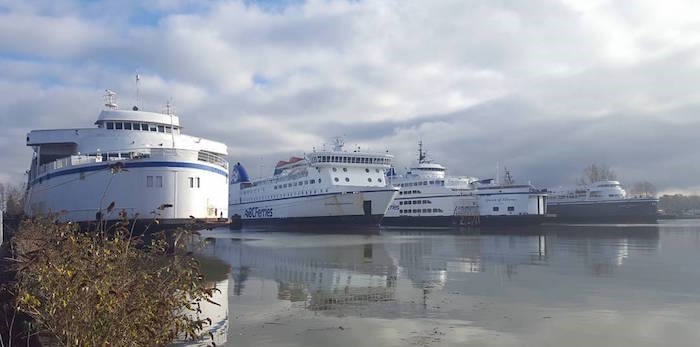When you're heading south on Highway 99 about to head into the Massey Tunnel, you may notice a line-up of BC Ferries to your right. Of course, the Fraser River isn't a BC Ferries route, so what exactly is going on here?
 Ferries at Deas Dock in November 2017 (@westcoastferries/Instagram)
Ferries at Deas Dock in November 2017 (@westcoastferries/Instagram)
Sure, some of you may already know the answer, but for some of us--well, for me--this was something I needed to look into. As it so happens, this is the location of what's known as "Deas Dock," the Richmond facility that serves as the "primary ship repair and maintenance location," for BC Ferries.
The formal name is the BC Ferries Fleet Maintenance Unit (FMU), though Deas Dock is also what used to be Deas Pacific Marine, and that was the site where the pieces of the George Massey Tunnel were built. The pieces were then floated out, sunk, and connected.
I reached out to BC Ferries to get the official details about the history of the facility, and the kind of work that goes on there. They provided this backgrounder:
"For over 40 years, work performed at the FMU includes: engine and mechanical overhauls, electrical, painting, welding, repair and overhaul of life saving appliances, plumping and various other skilled trades. FMU provides over 35 per cent of our total fleet ship repair, refit, modification, and maintenance services annually. This work equates to $30 million, so FMU is a core strategic business unit that needs to function at peak efficiency. Other work, including all drydockings, is conducted by other external local shipyards."
BC Ferries has a lot of employees on the payroll who work out of Deas Dock--250 of them, approximately. Those workers are in various departments, including the FMU, as well as in Supply Chain Management (SCM), Fleet Project Management Office (FPMO), Engineering Services, Fleet Renewal, Operational Training, Marketing and Travel Services, Commercial Services, and Employee Relations.
When there is much more work to be done with docked vessels during peak refit (which runs September through May) there are often up to 350 people working at Deas Dock, according to BC Ferries.
Which BC Ferries might you spot as you whiz by on Highway 99? Keep your eyes out for the vessels currently at the facility, which are:
Queen of Oak Bay, Queen of Capilano, Salish Orca, Northern Adventure and the Queen of Burnaby (retired).
The Salish Orca and the Queen of Burnaby are noteworthy dock-mates; the Orca was put into service in 2017 in the new Salish class of BC Ferries vessels on the Comox-Powell River route to replace the Queen of Burnaby following retirement.
You may remember the Queen of Burnaby getting some ink in December 2017, when it was put up for auction (at an initially low, low price). The highest bid was $653,000, though the sale is subject to approval by BC Ferries, and a stipulation is that the buyer must move the vessel out of Deas Dock.
"The Orca is having its refitting done eight months after it replaced Queen of Burnaby on the Comox-Powell River run in May 2017," noted the Powell River Peak in January. The Orca's twin vessel, the Salish Raven, is now running that route.
Now, the Massey Tunnel zone is definitely a hot topic these days, as talk of a bridge, or other repair/replacement alternatives have been in the news for years (and years). BC Ferries says that the bridge project remains under review by the Ministry of Transportation and Infrastructure, "however we don’t see it impacting our operation."
So the next time you pass by the Richmond side of the Massey Tunnel approach, look west and know the Ferries are there at Deas Dock.


